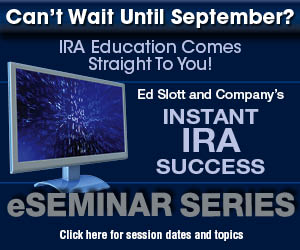 We have written many times on the importance of completing and filing a designated beneficiary form for all of your IRAs. If no designated beneficiary form is filed with your IRA custodian, or if one cannot be located, the identity of your beneficiary will be governed by default language contained in the IRA agreement, if any. Leaving to chance what may be the most critical aspect of your family’s financial future is not a smart planning move.
We have written many times on the importance of completing and filing a designated beneficiary form for all of your IRAs. If no designated beneficiary form is filed with your IRA custodian, or if one cannot be located, the identity of your beneficiary will be governed by default language contained in the IRA agreement, if any. Leaving to chance what may be the most critical aspect of your family’s financial future is not a smart planning move.
The beneficiary default provision in many IRA agreements may name the account owner’s surviving spouse, if any, as the primary beneficiary followed by surviving children and then the individual’s estate. Other agreements simply default to the estate. None of these scenarios may follow the path the IRA owner intended for the inheritance of his or her account and might actually cause family conflict.
In addition, many of the agreements may not contain the use of a “per stirpes” clause, meaning no provision would be made for the surviving issue of a child who predeceases the account owner, leaving grandchildren from that family out in the cold. Additionally, if the IRA assets go to the owner’s estate, the benefits of extended tax-deferred or tax-free compounding would be lost as no stretch IRA scenario would be available. Thus, every effort should be taken to avoid having beneficiary default language become operative.
As we have indicated in many past articles, you should conduct an annual IRA beneficiary audit to insure that your beneficiary designations, including the naming of both primary and contingent beneficiaries, are up to date and that the form can, in fact, be located. Life events such as divorce, marriage, re-marriage, and the birth of children and grandchildren may necessitate a change in your designated beneficiary form from time to time.
If an audit reveals that a beneficiary form cannot be located, don’t waste a lot of time trying to find it. Simply complete a new one and submit it to the IRA custodian. It is also generally a good idea to ask the custodian to acknowledge its receipt of the form by signing and returning a copy to you. You should retain a copy, keeping it in a proper place so that your heirs can locate it easily. A copy should also be provided to your advisor.
In addition to a missing designated beneficiary form, another problem may arise if an IRA owner cannot be located. If the owner is not eventually located, the IRA funds may be considered abandoned property and escheated to the state, depending on state law.
Just think, a mere 100 years ago there was no such thing as an IRA, the average US wage was 22 cents per hour, the average life expectancy for men was 47 years, and “Dancing With The Stars” did not yet exist. The 47-year life expectancy seems very low when compared to today’s standard. Oh, and the evolution of dance shoes has advanced significantly since then.
-By Marvin Rotenberg and Jared Trexler
Locating Your Missing IRA Beneficiary Form
Tuesday, September 20, 2011
No comments
Mailbag
Thursday's Slott Report Mailbag

Consumers: Send in Your Questions to [email protected]
Q:
Is a monthly retirement check considered income in order to open a Roth IRA?
A:
An IRA contribution must be based on the taxable compensation of the individual for the year of the contribution. Pension, profit sharing or IRA distributions are not considered compensation for the purpose of a contribution to an IRA. Here is a Q&A; article we did on Roth IRA and IRA contributions.


 Articles That Move
Articles That Move







0 comments:
Post a Comment